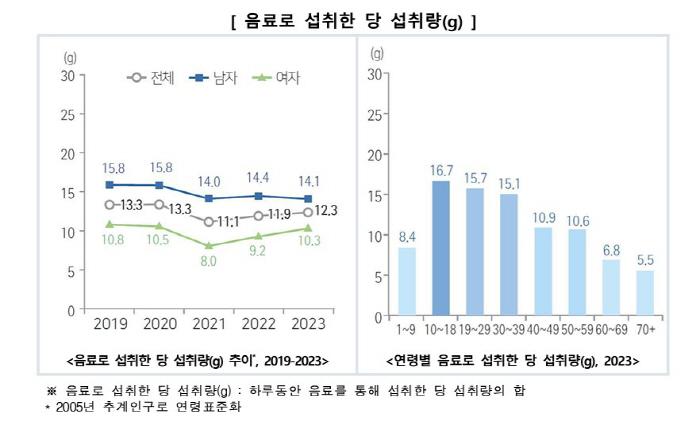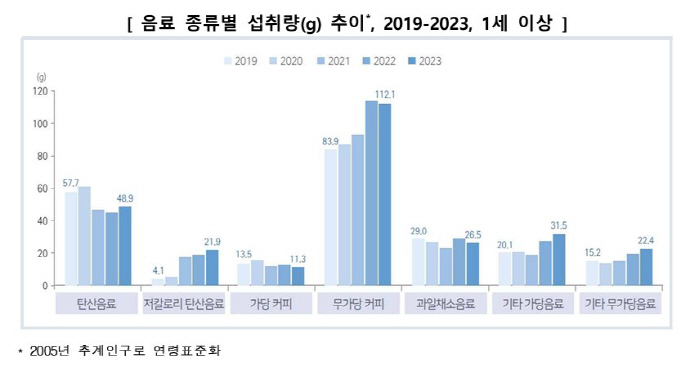Drink Intake Over 20% Over the Last 5 Years ↑…Young People Still Consuming Sugary Beverages
|
|
Drinks, which are liquid foods for water intake, etc., are classified into unsweetened and sweetened beverages depending on whether sugars (sugar, liquid fructose, etc.) are added. Among them, sugary drinks are known as risk factors for chronic diseases such as obesity, diabetes, and cardiovascular diseases by making it easy to consume energy and sugar. According to the Korean Nutrient Intake Standards, it is recommended that the total sugar intake be less than 20% of the total energy intake and less than 10% of the added sugar contained in sugary drinks.
According to the Korea Centers for Disease Control and Prevention's announcement on the 9th through the National Health Statistics Plus that the average daily drink consumption of Koreans (1 year old or older, standardized) was 274.6g in 2023, up more than 20% (more than 50g) from 223.5g in 2019.
In terms of gender, men (30.0g) drink more than women (247.2g). By age, people in their 30s (415.3g) were ranked first by drinking an average of two or more drinks per day (based on 200ml), followed by people in their 20s and 40s, who drank an average of 1.5 drinks per day.
As of 2023, the most consumed drink (aged 1 and older, standardized) was unsweetened coffee (Americano et al., 112.1 g), followed by soda (48.9 g). In the last five years, consumption of unsweetened coffee (↑28.2g) and low-calorie soft drinks (↑17.8g) has increased, while consumption of sugar-containing soft drinks (↓8.8g) has decreased.
Children and adolescents were mainly found to drink sugary drinks containing sugar. Children mainly consumed fruit and vegetable drinks and carbonated drinks, and adolescents had the highest consumption of carbonated drinks. In adults, consumption of unsweetened coffee and low-calorie soft drinks increased significantly, while young people aged 19-39 still consumed a lot of sugar-containing soft drinks along with unsweetened coffee.
Contrary to the increasing trend of beverage intake, sugar intake as a beverage decreased somewhat (about 1.0 g). Changes in beverage types, such as increased choice of unsweetened coffee and low-calorie carbonated drinks, were found to have led to a decrease in sugar intake. Beverage intake was highest in the 30s, but the age with the highest sugar intake as a drink was teenagers who mainly consumed sweetened beverages, and those in their 20s and 30s were also higher than those of other age groups.
Drinkers were more likely to consume excessive sugar than those who did not drink. In particular, in the case of children, adolescents, and people in their 20s with high consumption of sugary drinks, the percentage of excessive sugar intake of drinkers was more than twice as high as that of non-drinkers.
Ji Young-mi, Director of the Korea Centers for Disease Control and Prevention, said "In the case of children and adolescents, obesity caused by consumption of sugary drinks can lead to chronic diseases in adulthood, so active attention and efforts are needed to reduce consumption of sugary drinks in the government, schools and families."Changes in beverage intake patterns, such as low calories and increased consumption of low-sugar beverages among adults, can be positive in terms of reducing energy and sugar intake, but people in their 20s and 30s still drink a lot of soda, so it is recommended to drink enough water instead of beverages for water intake," he stressed.
This article was translated by Naver AI translator.





